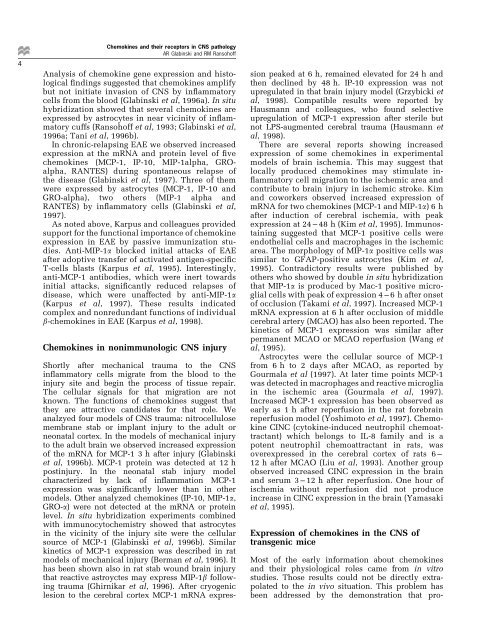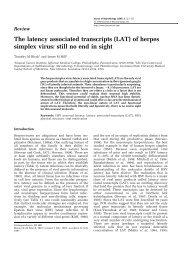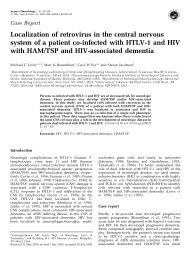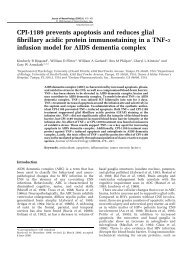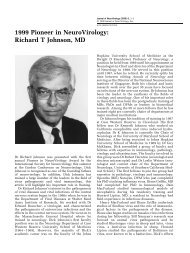Chemokines and chemokine receptors in CNS pathology
Chemokines and chemokine receptors in CNS pathology
Chemokines and chemokine receptors in CNS pathology
You also want an ePaper? Increase the reach of your titles
YUMPU automatically turns print PDFs into web optimized ePapers that Google loves.
4<br />
<strong>Chemok<strong>in</strong>es</strong> <strong>and</strong> their <strong>receptors</strong> <strong>in</strong> <strong>CNS</strong> <strong>pathology</strong><br />
AR Glab<strong>in</strong>ski <strong>and</strong> RM Ransohoff<br />
Analysis of <strong>chemok<strong>in</strong>e</strong> gene expression <strong>and</strong> histological<br />
®nd<strong>in</strong>gs suggested that <strong>chemok<strong>in</strong>e</strong>s amplify<br />
but not <strong>in</strong>itiate <strong>in</strong>vasion of <strong>CNS</strong> by <strong>in</strong>¯ammatory<br />
cells from the blood (Glab<strong>in</strong>ski et al, 1996a). In situ<br />
hybridization showed that several <strong>chemok<strong>in</strong>e</strong>s are<br />
expressed by astrocytes <strong>in</strong> near vic<strong>in</strong>ity of <strong>in</strong>¯ammatory<br />
cuffs (Ransohoff et al, 1993; Glab<strong>in</strong>ski et al,<br />
1996a; Tani et al, 1996b).<br />
In chronic-relaps<strong>in</strong>g EAE we observed <strong>in</strong>creased<br />
expression at the mRNA <strong>and</strong> prote<strong>in</strong> level of ®ve<br />
<strong>chemok<strong>in</strong>e</strong>s (MCP-1, IP-10, MIP-1alpha, GROalpha,<br />
RANTES) dur<strong>in</strong>g spontaneous relapse of<br />
the disease (Glab<strong>in</strong>ski et al, 1997). Three of them<br />
were expressed by astrocytes (MCP-1, IP-10 <strong>and</strong><br />
GRO-alpha), two others (MIP-1 alpha <strong>and</strong><br />
RANTES) by <strong>in</strong>¯ammatory cells (Glab<strong>in</strong>ski et al,<br />
1997).<br />
As noted above, Karpus <strong>and</strong> colleagues provided<br />
support for the functional importance of <strong>chemok<strong>in</strong>e</strong><br />
expression <strong>in</strong> EAE by passive immunization studies.<br />
Anti-MIP-1a blocked <strong>in</strong>itial attacks of EAE<br />
after adoptive transfer of activated antigen-speci®c<br />
T-cells blasts (Karpus et al, 1995). Interest<strong>in</strong>gly,<br />
anti-MCP-1 antibodies, which were <strong>in</strong>ert towards<br />
<strong>in</strong>itial attacks, signi®cantly reduced relapses of<br />
disease, which were unaffected by anti-MIP-1a<br />
(Karpus et al, 1997). These results <strong>in</strong>dicated<br />
complex <strong>and</strong> nonredundant functions of <strong>in</strong>dividual<br />
b-<strong>chemok<strong>in</strong>e</strong>s <strong>in</strong> EAE (Karpus et al, 1998).<br />
<strong>Chemok<strong>in</strong>es</strong> <strong>in</strong> nonimmunologic <strong>CNS</strong> <strong>in</strong>jury<br />
Shortly after mechanical trauma to the <strong>CNS</strong><br />
<strong>in</strong>¯ammatory cells migrate from the blood to the<br />
<strong>in</strong>jury site <strong>and</strong> beg<strong>in</strong> the process of tissue repair.<br />
The cellular signals for that migration are not<br />
known. The functions of <strong>chemok<strong>in</strong>e</strong>s suggest that<br />
they are attractive c<strong>and</strong>idates for that role. We<br />
analzyed four models of <strong>CNS</strong> trauma: nitrocellulose<br />
membrane stab or implant <strong>in</strong>jury to the adult or<br />
neonatal cortex. In the models of mechanical <strong>in</strong>jury<br />
to the adult bra<strong>in</strong> we observed <strong>in</strong>creased expression<br />
of the mRNA for MCP-1 3 h after <strong>in</strong>jury (Glab<strong>in</strong>ski<br />
et al, 1996b). MCP-1 prote<strong>in</strong> was detected at 12 h<br />
post<strong>in</strong>jury. In the neonatal stab <strong>in</strong>jury model<br />
characterized by lack of <strong>in</strong>¯ammation MCP-1<br />
expression was signi®cantly lower than <strong>in</strong> other<br />
models. Other analyzed <strong>chemok<strong>in</strong>e</strong>s (IP-10, MIP-1a,<br />
GRO-a) were not detected at the mRNA or prote<strong>in</strong><br />
level. In situ hybridization experiments comb<strong>in</strong>ed<br />
with immunocytochemistry showed that astrocytes<br />
<strong>in</strong> the vic<strong>in</strong>ity of the <strong>in</strong>jury site were the cellular<br />
source of MCP-1 (Glab<strong>in</strong>ski et al, 1996b). Similar<br />
k<strong>in</strong>etics of MCP-1 expression was described <strong>in</strong> rat<br />
models of mechanical <strong>in</strong>jury (Berman et al, 1996). It<br />
has been shown also <strong>in</strong> rat stab wound bra<strong>in</strong> <strong>in</strong>jury<br />
that reactive astroyctes may express MIP-1b follow<strong>in</strong>g<br />
trauma (Ghirnikar et al, 1996). After cryogenic<br />
lesion to the cerebral cortex MCP-1 mRNA expression<br />
peaked at 6 h, rema<strong>in</strong>ed elevated for 24 h <strong>and</strong><br />
then decl<strong>in</strong>ed by 48 h. IP-10 expression was not<br />
upregulated <strong>in</strong> that bra<strong>in</strong> <strong>in</strong>jury model (Grzybicki et<br />
al, 1998). Compatible results were reported by<br />
Hausmann <strong>and</strong> colleagues, who found selective<br />
upregulation of MCP-1 expression after sterile but<br />
not LPS-augmented cerebral trauma (Hausmann et<br />
al, 1998).<br />
There are several reports show<strong>in</strong>g <strong>in</strong>creased<br />
expression of some <strong>chemok<strong>in</strong>e</strong>s <strong>in</strong> experimental<br />
models of bra<strong>in</strong> ischemia. This may suggest that<br />
locally produced <strong>chemok<strong>in</strong>e</strong>s may stimulate <strong>in</strong>-<br />
¯ammatory cell migration to the ischemic area <strong>and</strong><br />
contribute to bra<strong>in</strong> <strong>in</strong>jury <strong>in</strong> ischemic stroke. Kim<br />
<strong>and</strong> coworkers observed <strong>in</strong>creased expression of<br />
mRNA for two <strong>chemok<strong>in</strong>e</strong>s (MCP-1 <strong>and</strong> MIP-1a) 6h<br />
after <strong>in</strong>duction of cerebral ischemia, with peak<br />
expression at 24 ± 48 h (Kim et al, 1995). Immunosta<strong>in</strong><strong>in</strong>g<br />
suggested that MCP-1 positive cells were<br />
endothelial cells <strong>and</strong> macrophages <strong>in</strong> the ischemic<br />
area. The morphology of MIP-1a positive cells was<br />
similar to GFAP-positive astrocytes (Kim et al,<br />
1995). Contradictory results were published by<br />
others who showed by double <strong>in</strong> situ hybridization<br />
that MIP-1a is produced by Mac-1 positive microglial<br />
cells with peak of expression 4 ± 6 h after onset<br />
of occlusion (Takami et al, 1997).IncreasedMCP-1<br />
mRNA expression at 6 h after occlusion of middle<br />
cerebral artery (MCAO) has also been reported. The<br />
k<strong>in</strong>etics of MCP-1 expression was similar after<br />
permanent MCAO or MCAO reperfusion (Wang et<br />
al, 1995).<br />
Astrocytes were the cellular source of MCP-1<br />
from 6 h to 2 days after MCAO, as reported by<br />
Gourmala et al (1997). At later time po<strong>in</strong>ts MCP-1<br />
was detected <strong>in</strong> macrophages <strong>and</strong> reactive microglia<br />
<strong>in</strong> the ischemic area (Gourmala et al, 1997).<br />
Increased MCP-1 expression has been observed as<br />
early as 1 h after reperfusion <strong>in</strong> the rat forebra<strong>in</strong><br />
reperfusion model (Yoshimoto et al, 1997). Chemok<strong>in</strong>e<br />
CINC (cytok<strong>in</strong>e-<strong>in</strong>duced neutrophil chemoattractant)<br />
which belongs to IL-8 family <strong>and</strong> is a<br />
potent neutrophil chemoattractant <strong>in</strong> rats, was<br />
overexpressed <strong>in</strong> the cerebral cortex of rats 6 ±<br />
12 h after MCAO (Liu et al, 1993). Another group<br />
observed <strong>in</strong>creased CINC expression <strong>in</strong> the bra<strong>in</strong><br />
<strong>and</strong> serum 3 ± 12 h after reperfusion. One hour of<br />
ischemia without reperfusion did not produce<br />
<strong>in</strong>crease <strong>in</strong> CINC expression <strong>in</strong> the bra<strong>in</strong> (Yamasaki<br />
et al, 1995).<br />
Expression of <strong>chemok<strong>in</strong>e</strong>s <strong>in</strong> the <strong>CNS</strong> of<br />
transgenic mice<br />
Most of the early <strong>in</strong>formation about <strong>chemok<strong>in</strong>e</strong>s<br />
<strong>and</strong> their physiological roles came from <strong>in</strong> vitro<br />
studies. Those results could not be directly extrapolated<br />
to the <strong>in</strong> vivo situation. This problem has<br />
been addressed by the demonstration that pro-


